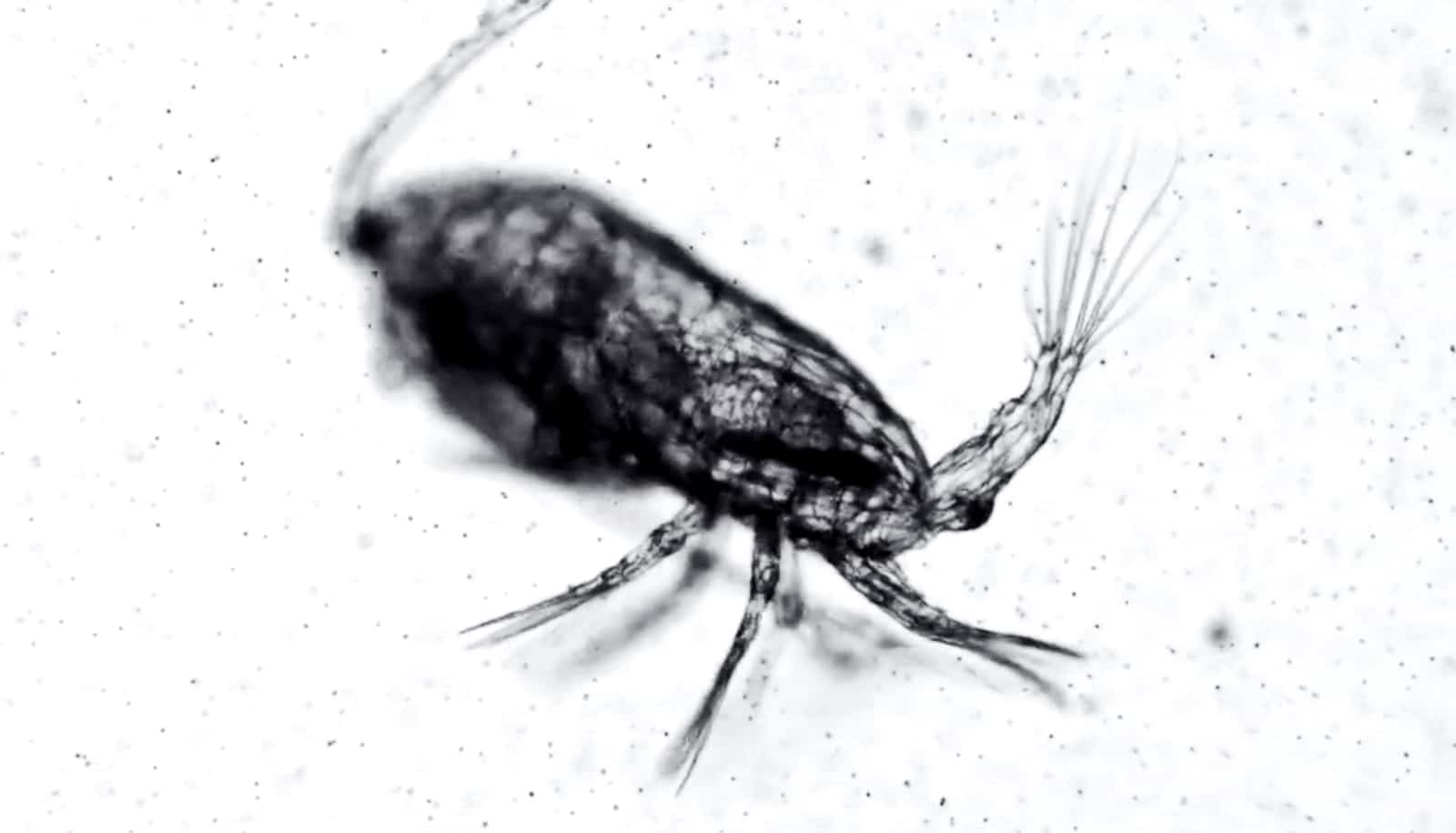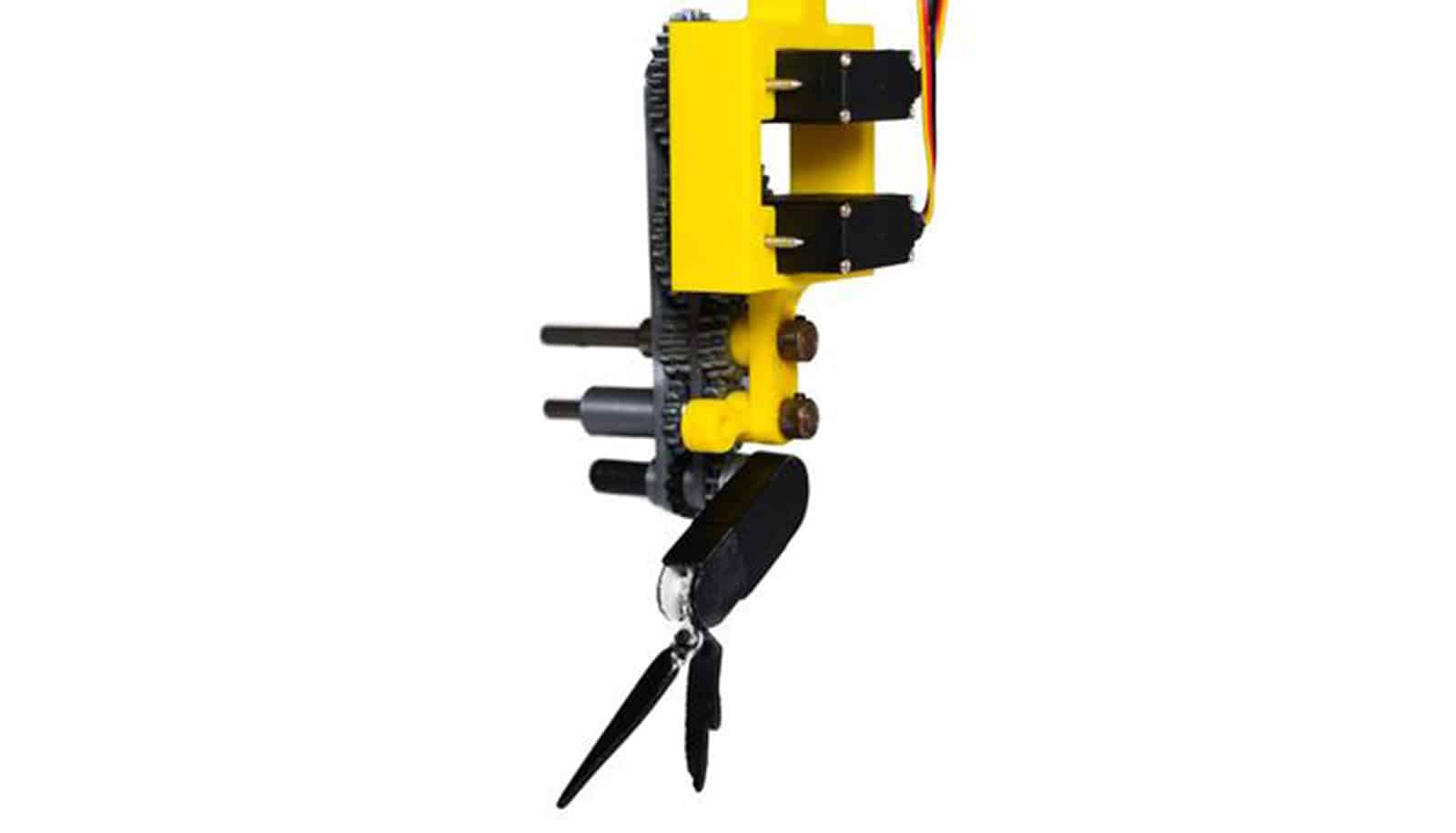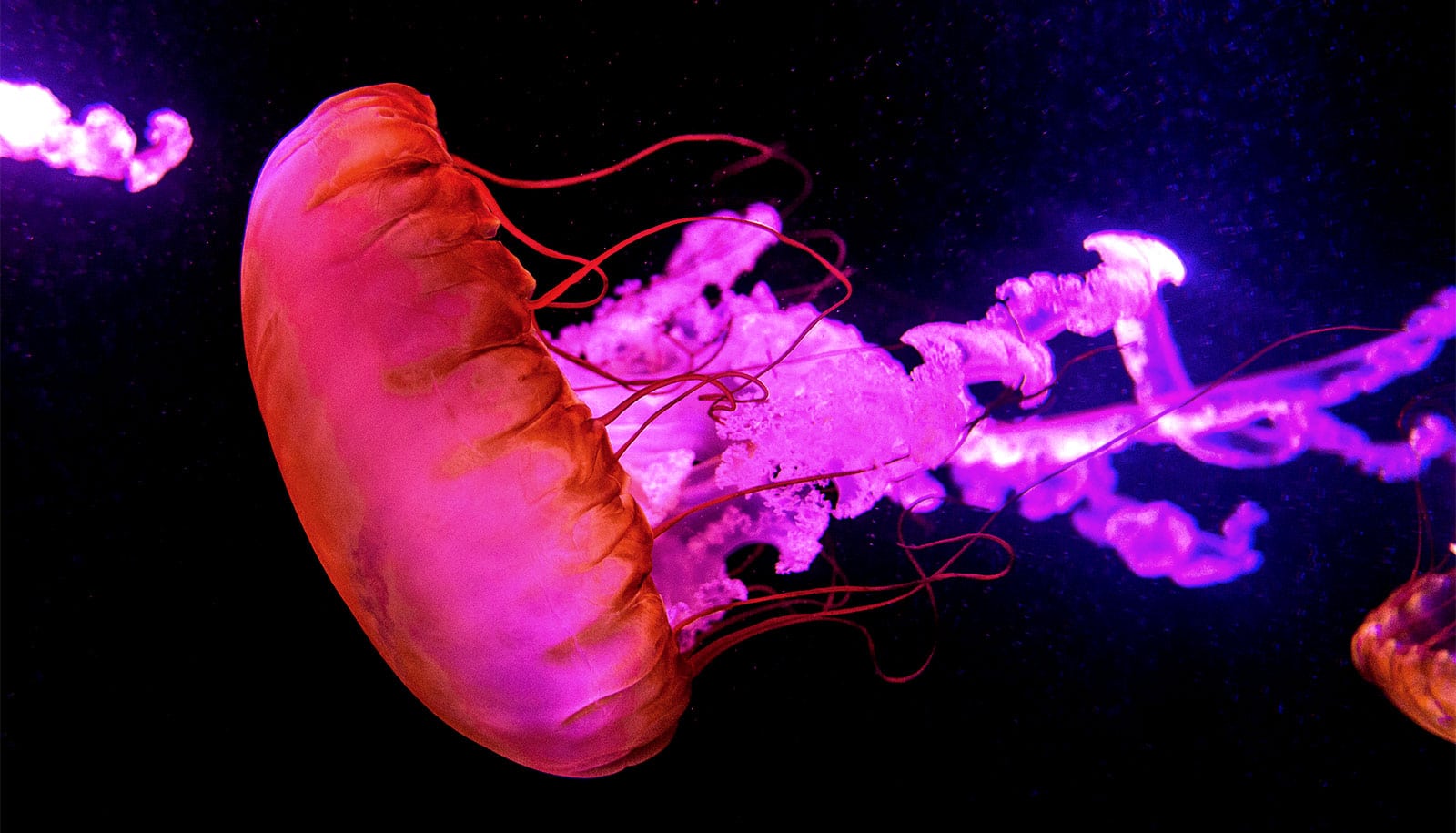
“When we swim, we barely notice water's viscosity,” George von Dassow says. “We notice that it's heavy and hard to push around. To small organisms, however, water is very sticky, and, to them, water feels about like it would to us if we had to swim in Karo syrup.” (Credit: U. Oregon)
Physics-defying ocean critter’s ‘propeller’ caught on camera
"These incredibly abundant and ecologically-important marine animals have a neat trick to beat the physics of their environment..."
Researchers have captured on video the physics-defying trick a tiny crustacean called Acartia uses to move through water.
Walk along an Oregon beach and scoop up standing water left by the tide. Inside it you’ll likely see tiny flecks moving at high speed. They probably are copepods, abundant aquatic crustaceans, barely two millimeters long, that are an integral part of the ocean’s food web.
Researchers recently scooped water from Charleston Marina to gather a bunch of these tiny sea creatures and study them under a microscope and with high-speed videography.
George von Dassow and Richard Emlet of the Oregon Institute of Marine Biology at the University of Oregon were especially curious because former graduate student Ella Lamont had made a remarkable discovery about the swimming legs of barnacle larvae.
The marine biologists wanted to know if copepods, the dominant animals in ocean plankton , have a similar biological mechanism for acceleration.
In a paper in Biological Bulletin , they documented that, at least for the common copepod species Acartia, their suspicion was correct.
The physics-defying Acartia
“These incredibly abundant and ecologically-important marine animals have a neat trick to beat the physics of their environment,” says von Dassow.
“They’ve made a paddle out of a lightweight, elastic material that nearly isn’t there, but which likely behaves almost like a solid and allows them to get going fast enough that they break away from the water’s viscosity.”
Copepods form, as do barnacles , a short-lived fan-like structure by linking extracellular filaments of their cuticle—much like fingernails, hair, or feathers—to create paddles on their swimming legs. The paddles are open meshworks of exoskeleton that open and close in less than 10 milliseconds with each swimming stroke. A sweeping, arc-like movement of these paddles, captured on video, enables bursts of speed that defy the physics and help escape danger.
“When we swim, we barely notice water’s viscosity,” von Dassow says. “We notice that it’s heavy and hard to push around. To small organisms, however, water is very sticky, and, to them, water feels about like it would to us if we had to swim in Karo syrup.”
In effect, the limbs in copepods become much larger and more powerful than is possible if they relied on living tissue, he says. The transition is similar, he adds, to how birds mastered the air by making large vaned feathers.
The earlier discovery in barnacles by Lamont and her mentor, Emlet, drew little interest from publishers when they initially submitted her documentation. Eventually, Biological Bulletin published the work in 2018. That research focused on the cross-linked swimming legs of cyprids, the last-stage larva of barnacles.
Lamont, who is now at the University of Washington where she is a research associate in the School of Dentistry, says she was happy to hear that Emlet and von Dassow used her findings as a catalyst for additional research.
“Barnacles are one of my favorite animals, and I wanted to study them for my master’s work,” she says. “Richard suggested that I could do something along the lines of describing how cyprids swim. There had been a lot of work on cyprids and how they cement themselves to things, such as boats, but there was almost no description of cyprid swimming in the literature.”
She spent hours with Emlet’s high-speed camera trying to capture cyprid swimming. In doing so, she captured how quickly they could move and what their appendages were doing.
“Cyprids are positively photoactive, so I basically had to sit in the dark for several minutes, then turn on the lights and hope that the cyprid would swim in front of the camera,” she recalls.
‘Curiosity-driven research’
Researchers have also extensively studied copepods. In 2003, scientists at the University of Texas Marine Science Institute in Port Aransas used high-speed videography to document a burst of speed some 10 times higher than the crustaceans’ normal movement, but that work did not capture how it was accomplished.
“Our findings in copepods is really an extension of Ella’s discovery,” von Dassow says. “It is basic natural-history, curiosity-driven research, the kind of discovery science that marine labs are here for.”
The project was tricky, he says. Copepods are delicate and difficult to handle without causing physical damage to them.
“Many of our recordings were made by putting a small number of copepods in a small petri dish with a glass coverslip for a bottom,” he says. “They tend to sit still for a while if nothing disturbs them, but they disturb each other. When I put a half-dozen in a dish they played musical chairs, and I was able to catch them on camera as they swam across the field of view.”
That, he says, happens quickly, to the tune of 10 milliseconds, and recording it required a video camera that can capture 8,000 frames per second. By comparison, normal video runs at 30 frames per second, or 33 milliseconds between frames, which is faster than humans can see but much slower than the copepods’ bursts of speed. Aiming the microscope isn’t possible, he says: one just has to wait for the animals to cross the field of view.
“Once in maybe 10 or 100 tries, I got a glimpse of something worth seeing,” von Dassow says. “The key sequences we showed in our paper that caught the mesh clearly were literally one-in-a-thousand lucky grabs.”
The new findings apply to both adults and to pre-adult molting stages of Acartia, which have an overall life span of about a month, like many insects, he says.
“There are important ecological questions raised by this work,” von Dassow says. “Everything from fellow crustaceans to baleen whales like to eat these animals. They have this rapid escape response for some reason. It’s energetically expensive and they probably don’t just do it for fun, so it is likely important to their survival.”
On the coast, copepods are both hard to see and hard to avoid. Certain species are abundant in splash pools on the coast, where beachcombers are most likely to notice them, von Dassow says.
“Without a plankton net to concentrate them, there might not be more than a few in a quart, but they’d be there,” he says.
“Over the course of many open houses, I’ve found that there are two kinds of people in the world: those who respond to this news by saying, ‘really, the water’s full of beautiful things like that?’ and those who say, ‘you mean those are getting in my shorts when I go swimming?'”
Source: University of Oregon
The post Physics-defying ocean critter’s ‘propeller’ caught on camera appeared first on Futurity .
Share this article:
This article uses material from the Futurity article, and is licenced under a CC BY-SA 4.0 International License. Images, videos and audio are available under their respective licenses.
Related Articles:
Krill inspire robots for ocean exploration
July 5, 2023 • futurityJellyfish robot outswims the real thing
July 1, 2020 • futurityLinks/images:
- https://www.futurity.org/plankton-turbulence-1389042/
- https://doi.org/10.1086/708303
- https://www.futurity.org/plastic-nanoparticles-1776382-2/
- https://doi.org/10.1086/700084
- https://around.uoregon.edu/content/tiny-crustaceans-speedy-propeller-caught-video
- https://www.futurity.org/acartia-crustaceans-plankton-swimming-movement-2373512/
- https://www.futurity.org


